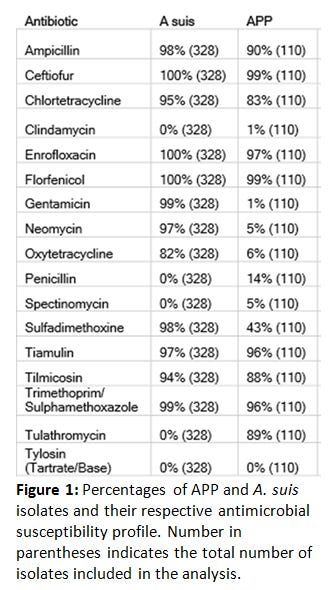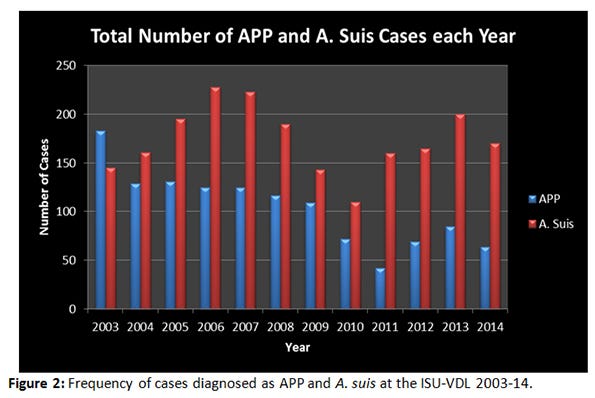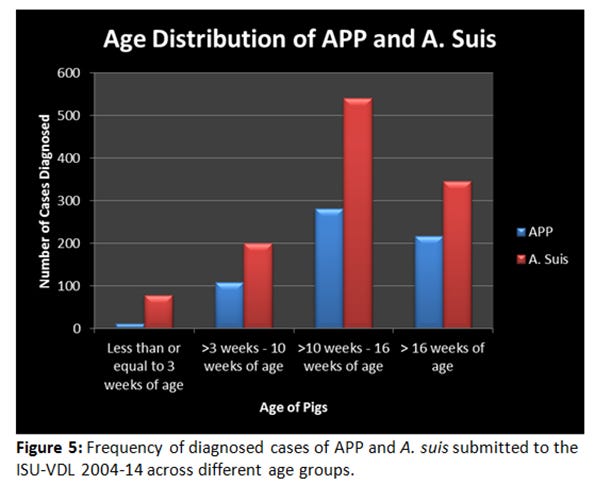August 3, 2015

Actinobacillus pleuropneumonia and Actinobacillus suis continue to be important causes of respiratory and systemic disease, respectively, in swine. The economic impact of these diseases has significantly increased with the intensification and consolidation of swine production. A diagnosis of APP has been associated with a 4.6% reduction in pork production.1 Mortality in litters due to A. suis can reach up to 50%.
A. pleuropneumonia is a coccobacilli, encapsulated rod, Gram-negative bacteria that is divided into biotypes I and II; the distinction of these types is essential when investigating suspect cases as the majority of strains from biotype II are endemic within upper respiratory tract of swine and are often of low or no virulence. Biotype I is divided into 13 different serotypes based on the capsular polysaccharides and the cell wall lipopolysaccharides.2 Four (1, 3, 5, 7) serotypes are most common in North America. Four exotoxins called RTX toxins – ApxI, ApxII, ApxIII and ApxIV – can be produced by APP organisms.3 These RTX toxins damage somatic and red blood cells. The toxin blend produced vary among serotypes. Antibodies to these exotoxins are likely important in protective immunity.
Transmission between animals occurs primarily by direct contact with introduction into a negative herd often occurring following the introduction of an infected pig.4 Colonization likely originates on the sow farm in a small percentage of piglets; however, disease expression is thought to be limited in this age due to high levels of maternal passive immunity.
Clinical disease is divided into peracute, acute and chronic forms and vary with age, immune status, environmental conditions and bacterial dose. The peracute form is characterized by severe, acute respiratory distress and fever. Animals are often found dead with marked diffuse cyanosis of the entire body and blood-tinged exudate within the nostrils. Multifocal to locally extensive necrohemorrhagic pneumonia with severe fibrinous pleuritis are often observed at necropsy. A diagnosis of APP at the Iowa State Veterinary Diagnostic Laboratory is often made by a combination of clinical signs, gross and histopathologic lesions, and the isolation of the bacteria. Recently, the ISU-VDL has introduced a polymerase chain reaction for serotype determination of an isolate which is important for epidemiologic and vaccine purposes. The disease is usually controlled by the use of antibiotics; however, successful treatment relies on early identification of disease. Preventative measures include avoiding the introduction of the bacteria into a naïve herds and use of vaccines in affected herds.
Closer look at Actinobacillus suis
A. suis is a Gram-negative, non-encapsulated bacterium known to cause septicemia and sudden death in both younger and older swine pigs. All isolates appear to be of a single serotype. This bacteria is endemic within the swine population5, it can be harvested from tonsil and nostrils of healthy pigs. Clinical disease is believed to occur only in specific circumstances such as less than optimal environmental conditions or concurrent diseases. The pathophysiology can be summarized in a stepwise processes 1) respiratory infection 2) dissemination of the bacteria through blood vessels 3) thrombi formation 4) necrosis and hemorrhage with bacterial colonies present in different organs (bacterial septicemia). The bacterium is sensitive to most antibiotics (Figure 1); however, the peracute course of disease makes treatment challenging. Autogenous vaccines have been used in hopes of preventing disease; however, they have not been evaluated critically. There are multiple types of lipopolysaccharides in A. suis, so matching the LPS profile of the vaccine strain to that of the pathogen is important.
To date there is no serologic test that reliably identifies infected swine to facilitate the establishment of A. suis-free herds. Antibodies to A. suis and A. pleuropneumoniae may cross-react with some serologic tests.
Diagnostic data
The series of charts below were constructed using diagnostic data from the ISU-VDL, from 2003-14 and provides general trends concerning the frequency of diagnosis, percentage of pneumonia cases diagnosed as APP, distribution across seasons and distribution across pig age.
The number of diagnosed cases of APP has been gradually decreasing over the years while the number of A. suis cases have not changed; the yearly variation observed likely fluctuates within the normal variation (Figure 2).
The number of cases of APP accounts for only a minor percentage of respiratory cases submitted to the ISU-VDL. As expected, the percentage of respiratory cases diagnosed as APP has been decreasing over the years (Figure 3).

An interesting trend in seasonality was noted when the number of cases by month was evaluated. The majority of APP or A. suis cases occurred in the cold months of the year (Figure 4).
Analysis concerning the number of diagnosed cases across different ages of pig showed an interesting and perhaps new trend where the majority of cases, particularly for A. suis, occurred in the middle to late finisher stage (Figure 5).
The ISU-VDL receives approximately 70,000 cases yearly, 75% of which are swine-related. Critical evaluation of this large body of data for possible trends can likely elucidate new patterns of disease in swine production and ultimately help researchers, diagnosticians and field veterinarians make informed and timely decisions.
References
Willard C. Losinger. Economic impacts of reduced pork production associated with the diagnosis of Actinobacillus pleuropneumoniae on grower/finisher swine operations in the United States. 2005. Prev Vet Med. 68: 181-193.
Blackall J, Klaasen H, van den Bosh, et al. 2002. Vet Microbiol. 84:47:52
Frey J. 2003. Methods Mol Biol. 216:87-95.
Zimmerman J, Karriker L, Ramirez R, Schwartz K. Disease of Swine, 10th edition. 653-666.
MacInnes J, Desrosiers R. 1999. Can J Vet Res. 63:83-89.
You May Also Like



